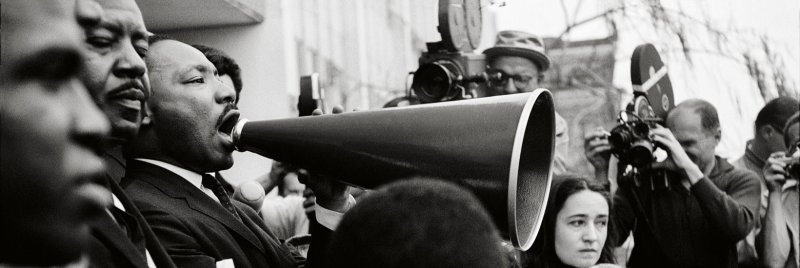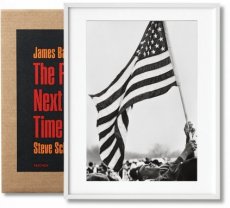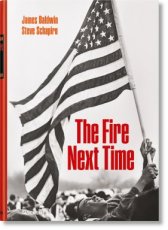James Baldwin. The Fire Next Time, Art Edition No. 101–150

Winner of the 2017 Lucie Award, Book Publisher of the Year for a Limited Edition.
First published in 1963, James Baldwin’s The Fire Next Time stabbed at the heart of America’s so-called “Negro problem.” As remarkable for its masterful prose as it is for its frank and personal account of the black experience in the United States, it is considered one of the most passionate and influential explorations of 1960s race relations, weaving thematic threads of love, faith, and family into a candid assault on the hypocrisy of the “land of the free.”
This Art Edition presents James Baldwin’s rich, raw, and ever relevant prose in letterpress with more than 100 photographs from Steve Schapiro, who traveled the American South with Baldwin for Life magazine. The encounter thrust Schapiro into the thick of the movement, allowing for vital, often iconic, images both of civil rights leaders—including Dr. Martin Luther King Jr., Rosa Parks, Fred Shuttlesworth, and Jerome Smith—and such landmark events as the March on Washington and the Selma March.
The dignity and pain of the civil rights movement culminated in the 54-mile-long Selma to Montgomery March—which took three attempts, the most violent of which was dubbed “Bloody Sunday.” Finally, on March 21, 1965, Dr. King successfully led a group of 300 protesters, who were given safe passage by 3,000 troops through some counties where conditions were so dire that not even a single African American was registered to vote. “Everyone was in awe,” says Schapiro, whose photographs from the march prevail as his most celebrated work. “No one knew what might have happened on that highway. Even though the National Guard was there, and helicopters were flying above.” Within months the Voting Rights Act was law, and by 1966, 241,000 black people were registered to vote.
Marking the year of original publication, The Fire Next Time is limited to 1,963 copies, each signed by Steve Schapiro. Copies No. 101–150 come with the signed print March for Freedom, Selma to Montgomery (1965)
The author
James Baldwin (1924–1987) was a novelist, essayist, playwright, poet, and social critic, and one of the most brilliant and provocative literary figures of the postwar era. His nonfiction collections, most notably Notes of a Native Son (1955) and The Fire Next Time (1963), and novels, including Giovanni’s Room (1956) and Another Country (1962), explore palpable yet unspoken intricacies of racial, sexual, and class distinctions in mid-20th-century America. A Harlem, New York, native, he primarily made his home in the south of France.
The photographer
American photojournalist Steve Schapiro has documented six decades of American culture, from the assassination of Martin Luther King Jr. and the presidential campaign of Robert F. Kennedy to Andy Warhol’s Factory and the filming of The Godfather trilogy. He has published a dozen books of his photographs, has exhibited his work in shows from Los Angeles to Moscow, and is represented in the permanent collections of the Smithsonian Institution, the Metropolitan Museum of Art, and the J. Paul Getty Museum, among others.
The contributing authors
Congressman John Lewis (b. 1940) played a key role in the struggle to end segregation—as a Freedom Rider, the chairman of the Student Nonviolent Coordinating Committee (SNCC), and an organizer of the March on Washington—and continues to serve as a prominent voice for social justice. He is the recipient of the Lincoln Medal, the John F. Kennedy Profile in Courage Lifetime Achievement Award, and the NAACP Spingarn Medal, among many other honors.
Gloria Karefa-Smart was born Gloria Esther Baldwin in Harlem. She traveled widely with her brother James and is the literary executor of his estate. She has lived in Freetown, Sierra Leone; New York’s Upper West Side; and Washington, D.C., where she still resides, and is the mother, grandmother, and great-grandmother of 22.
Marcia Davis is the news editor of The Marshall Project. A native of St. Louis, she spent more than 20 years as an editor and writer at The Washington Post, where she helped lead the coverage of the unrest in Ferguson, Missouri, after the fatal shooting of Michael Brown in 2014. She also worked at the Minneapolis Star Tribune and was senior editor of Emerge magazine.
Edition of 50
James Baldwin, Steve Schapiro, John Lewis, Gloria Karefa-Smart, Marcia Davis
Black-and-white gelatin silver print, 20.4 x 30.5 cm on 27.9 x 35.6 cm paper;
hardcover volume in a slipcase,
letterpress-printed text,
two different paper stocks, and tip-ins,
24 x 34 cm, 272 pages
Edition: English












